Discover the best team productivity apps to enhance collaboration and efficiency in 2025. Boost your team's workflow today!
Do less, be more with Fluidwave
Fluidwave combines smart task prioritization with an assistant marketplace — AI and human help, all in one productivity app.
June 17, 2025 (5mo ago)
Top 12 Team Productivity Apps to Boost Workflow in 2025
Discover the best team productivity apps to enhance collaboration and efficiency in 2025. Boost your team's workflow today!
← Back to blog
Unlocking Team Potential: A Guide to Productivity Powerhouses
In today's fast-paced work environment, effective team productivity apps are essential. They streamline communication, enhance collaboration, and drive project success. This detailed comparison of 12 leading team productivity apps – including Fluidwave, Slack, Asana, and more – provides the insights you need to choose the perfect tool for your team in 2025.
This listicle goes beyond generic feature lists. We'll explore real-world use cases, practical implementation advice, and honest assessments of each platform's strengths and limitations. Discover how each tool can address common team productivity challenges, such as:
- Communication bottlenecks:** Improve information flow and reduce email overload.
- Project management chaos: Centralize tasks, deadlines, and progress tracking.
- Remote work complexities: Bridge the gap for distributed teams.
- Meeting overload: Optimize meeting effectiveness and reduce wasted time.
From project management giants like Asana and Trello to communication hubs like Slack and Microsoft Teams, we'll cover a diverse range of tools. We'll also dive into specialized platforms like Miro for visual collaboration and Jira for software development teams. For students seeking similar productivity enhancements in their academic pursuits, this resource on Productivity Apps from Top 12 Productivity Apps For Students Ace Your Semester by Reseek offers valuable insights. By the end of this guide, you'll be equipped to select the ideal team productivity apps to maximize your team's efficiency and achieve your goals.
1. Fluidwave
Fluidwave is an AI-powered task management platform targeting busy professionals and teams. It aims to streamline workflows through intelligent automation and access to virtual assistants. The platform boasts multiple task views (table, list, calendar, Kanban, and cards) and prioritizes tasks using AI. A key differentiator is its pay-per-task delegation model, eliminating the need for a VA subscription.

Features and Benefits
Fluidwave excels in its AI-driven prioritization, helping users focus on critical tasks. The multiple view options cater to diverse work styles, increasing individual and team adaptability. The pay-per-task model provides cost-effective delegation solutions for those needing occasional assistance.
Pros and Cons
- Pros: AI-powered task prioritization, flexible task views, pay-per-task delegation, distraction-free interface, real-time collaboration.
- Cons: Limited initial VA availability, advanced AI features locked behind the Pro plan.
Pricing and Use Cases
Fluidwave offers a free tier with core features, making it accessible for individuals and small teams. The Pro plan unlocks advanced AI and costs $14.99 monthly, targeting users who benefit from enhanced automation. Visit their website (https://fluidwave.com) for more details.
Implementation and Recommendations
Fluidwave is ideal for teams and individuals seeking to improve task management and leverage AI. Its strength lies in prioritizing tasks and offering flexible delegation options. While the VA network is still developing, the core task management features make it a compelling team productivity app. Start with the free version and explore the Pro plan if advanced AI features align with your needs.
2. Slack
Slack is a comprehensive communication platform designed to streamline team collaboration. It achieves this through organized channels, direct messaging, and extensive integrations. It's become a central hub for many teams, replacing email for internal communication and fostering a more connected work environment.

Features and Benefits
Slack's channel-based messaging keeps discussions organized by project, topic, or team. Direct messaging and group chats facilitate quick communication. Integrated voice and video calls with screen sharing enhance collaboration. The platform's strength lies in its extensive integration with over 2,400 apps, including crucial tools like Google Drive and Asana. This connectivity streamlines workflows by centralizing information and actions.
Pros and Cons
- Pros: Intuitive user interface, extensive integration capabilities, effective real-time communication tools, robust search functionality.
- Cons: Free version has limited message history, the sheer number of channels and notifications can become overwhelming if not managed carefully.
Pricing and Use Cases
Slack offers a free plan with basic features, suitable for small teams getting started. Paid plans unlock features like unlimited message history, increased storage, and advanced administration tools. These plans cater to larger organizations and teams needing more control and archiving capabilities. Visit their website (https://slack.com) for detailed pricing information.
Implementation and Recommendations
Slack is ideal for teams seeking to consolidate communication and enhance collaboration. Its power lies in integrations, centralizing work-related information. Start with the free version to familiarize your team with the platform. Consider paid plans as your team grows and communication history becomes more critical. Implement channel management best practices early on to avoid notification overload and maintain a productive workspace. This includes clear channel naming conventions and guidelines for communication within each channel.
3. Asana
Asana is a project management tool that helps teams organize, track, and manage their work efficiently. It offers a central hub for task assignments, project timelines, and progress tracking. With customizable workflows and robust integrations, Asana adapts to diverse team needs and project styles. Learn more about Asana project management insights.
Features and Benefits
Asana excels in providing flexible project views (list, board, calendar) to suit various work preferences. Its robust integration with over 200 apps, including Slack and Google Drive, streamlines workflows. For teams using Slack, consider ways to streamline workflows; here are 5 tasks you can automate with Slack apps. The platform's automation features and reporting dashboards further enhance team productivity.
Pros and Cons
- Pros: User-friendly interface, flexible project views, robust integration options, customizable workflows.
- Cons: Advanced features require paid plans, can have a steep learning curve for new users.
Pricing and Use Cases
Asana offers a free tier for basic project management. Paid plans unlock advanced features like custom fields and reporting, starting at $10.99 per user/month. This makes it suitable for various teams, from small startups to larger organizations.
Implementation and Recommendations
Asana is ideal for teams seeking a centralized platform for managing projects and tasks. Its strength lies in its flexibility and integrations. While the free version is sufficient for basic needs, consider a paid plan to unlock the full potential of Asana's features. Begin by mapping your current workflow and exploring Asana's templates to expedite setup.
4. Trello
Trello is a visual project management tool leveraging boards, lists, and cards to organize and prioritize projects. Its Kanban-style approach makes it easy to visualize workflow and track progress. Trello is highly adaptable for various team productivity needs, from marketing campaigns to software development. Its simple interface makes it quick to learn and implement for teams of all sizes.
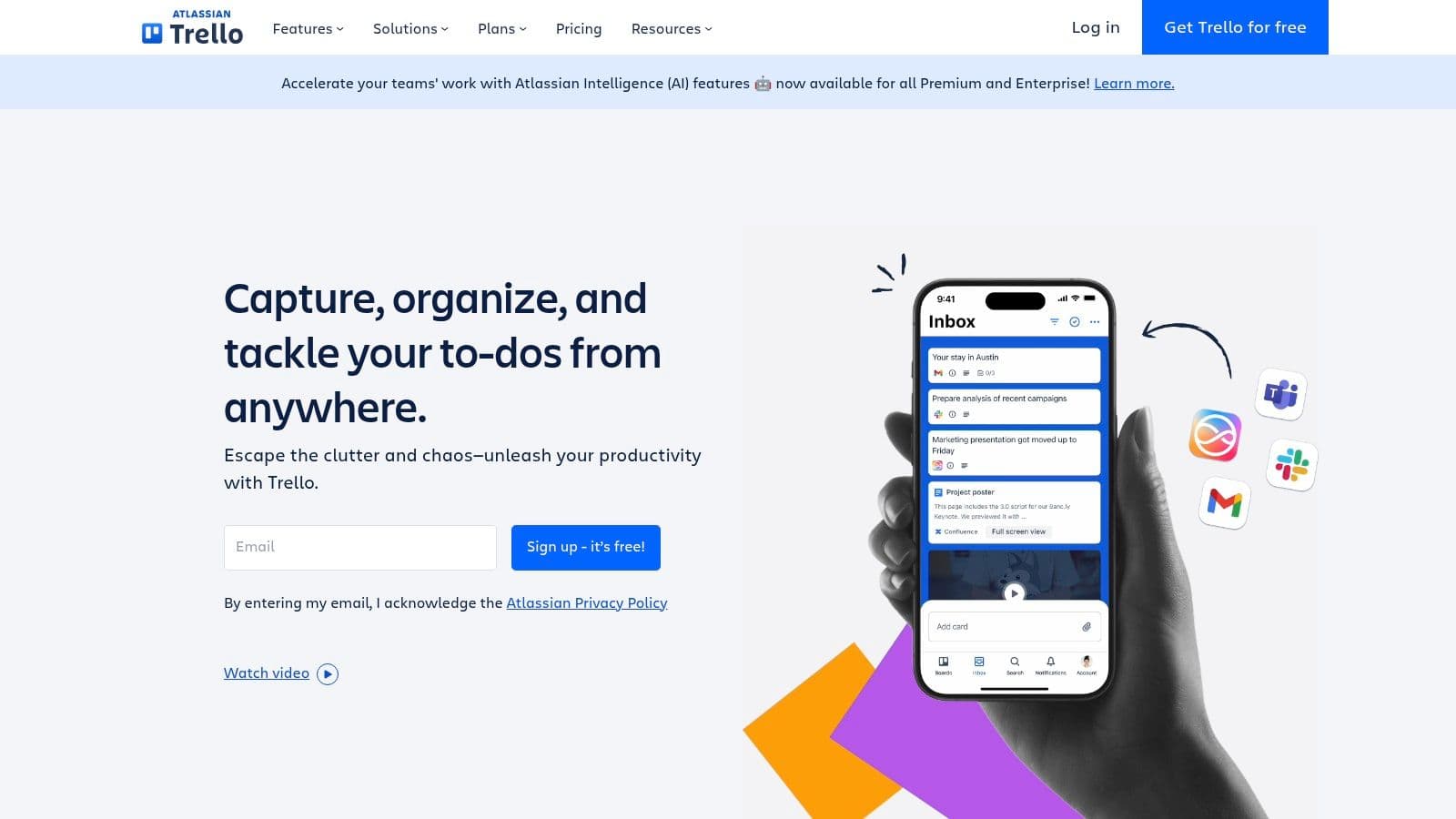
Features and Benefits
Trello's drag-and-drop interface simplifies task management. Customizable boards and lists allow teams to tailor the tool to their specific workflows. Integrations with popular apps like Slack and Google Drive enhance collaboration and streamline communication. The "Butler" automation feature allows for rule-based actions, further boosting team productivity.
Pros and Cons
- Pros: Simple and intuitive interface, highly customizable, free plan offers substantial functionality, excellent mobile app, robust integrations.
- Cons: Limited advanced features in the free version, may not be suitable for highly complex project management needs, can become cluttered with large projects.
Pricing and Use Cases
Trello offers a generous free plan suitable for individuals and small teams. Paid plans unlock advanced features like unlimited boards, custom fields, and advanced automation, starting at $5 per user per month. Visit their website (https://trello.com) for details.
Implementation and Recommendations
Trello excels for teams seeking a visual and flexible project management solution. It's ideal for managing editorial calendars, tracking sales leads, or organizing sprint cycles. Start with a simple board and progressively add features as needed. While the free version is powerful, consider a paid plan for larger teams requiring advanced features and integrations to maximize team productivity apps benefits.
5. Notion
Notion is an all-in-one workspace that combines note-taking, project management, and collaboration tools. It's highly customizable, allowing teams to build their perfect workflow using databases, wikis, kanban boards, and calendars, all within a single platform. This flexibility makes Notion a powerful tool for managing diverse projects, from marketing campaigns to software development.
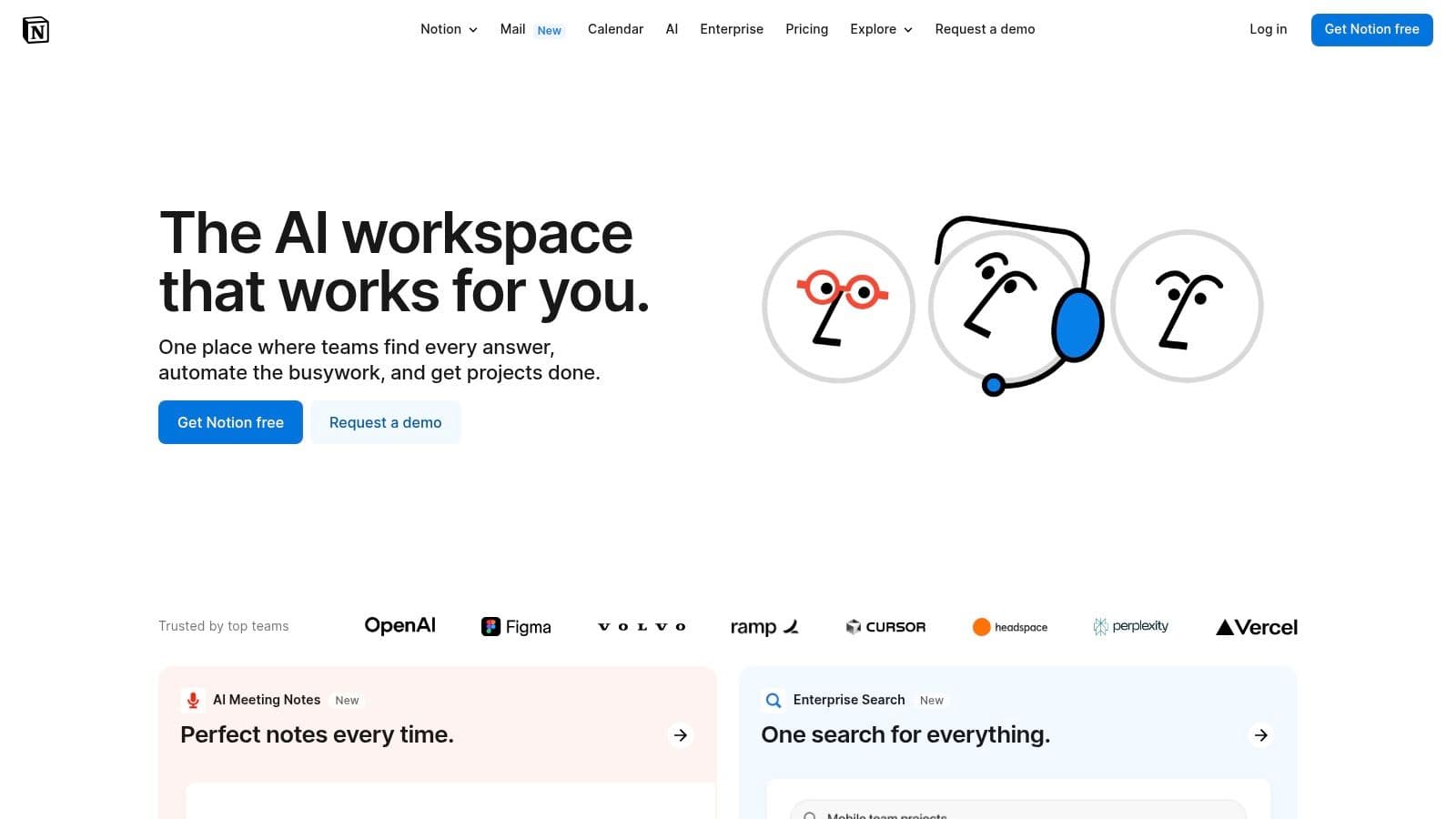
Features and Benefits
Notion excels in its customizability. Its modular blocks allow users to build pages tailored to their specific needs. Real-time collaboration features streamline teamwork, while the extensive template library provides a jumpstart for various use cases. This adaptability makes it a strong contender among team productivity apps.
Pros and Cons
- Pros: Highly customizable, all-in-one platform, strong community support, extensive template library, real-time collaboration.
- Cons: Can have a steep learning curve, mobile app experience could be improved, offline functionality has limitations.
Pricing and Use Cases
Notion offers a free plan suitable for individual use and small teams exploring its features. Paid plans unlock additional features like team collaboration and increased file uploads, starting at $8 per user per month. Visit their website (https://www.notion.so) for detailed pricing.
Implementation and Recommendations
Notion is ideal for teams seeking a highly customizable and centralized workspace. Its flexibility can be a double-edged sword. Invest time in exploring templates and building a system that works for your team. Start with a simple setup and gradually incorporate more advanced features as needed. This approach mitigates the learning curve and maximizes Notion's potential as a powerful team productivity app.
6. Microsoft Teams
Microsoft Teams is a collaboration platform that integrates chat, video meetings, file storage, and application integration, making it a central hub for team communication and project management. It's deeply embedded within the Microsoft 365 ecosystem, offering seamless interoperability with familiar tools like Word, Excel, and PowerPoint. This integration simplifies workflows and reduces context switching for teams already reliant on Microsoft products.
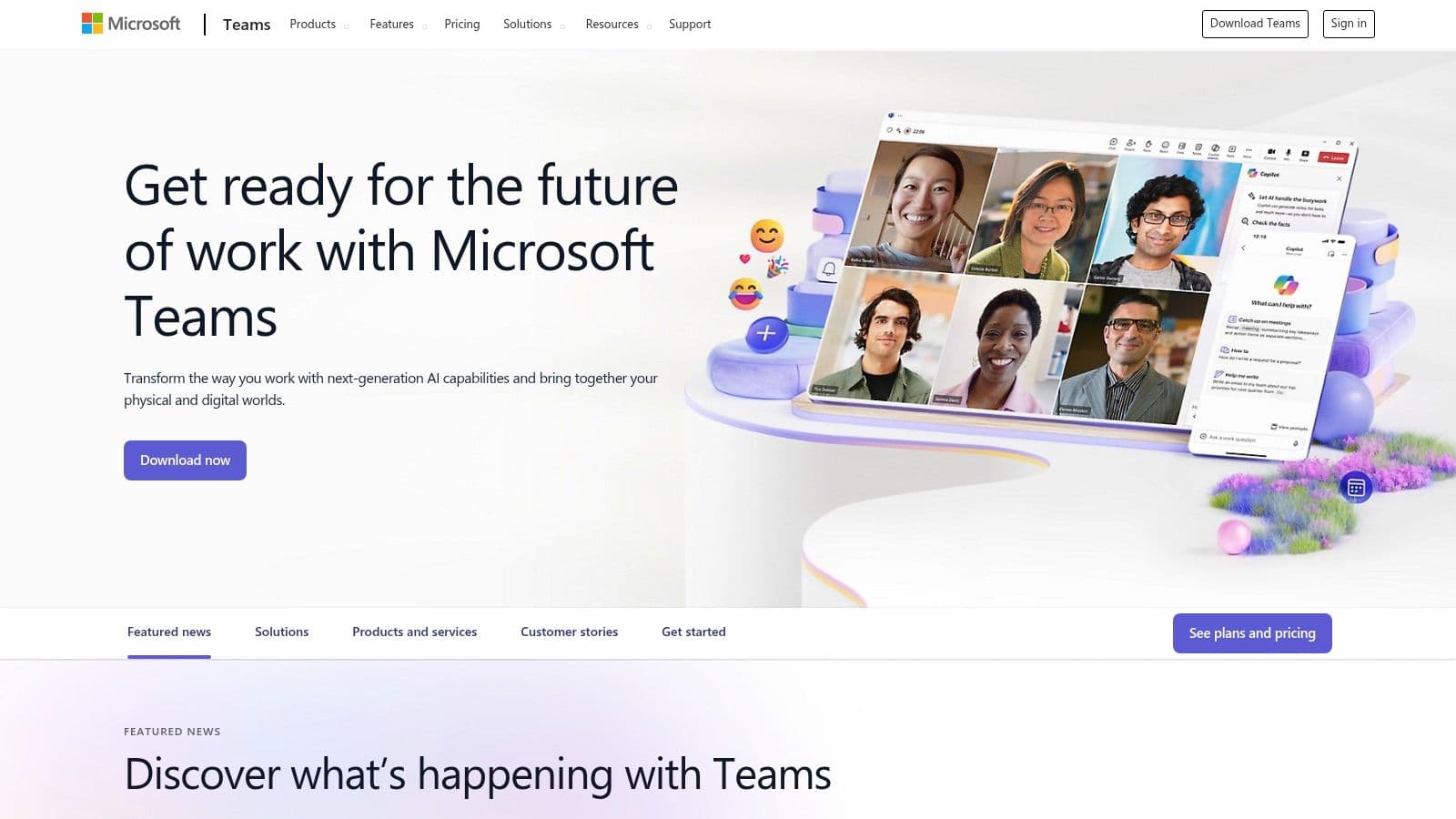
Features and Benefits
Teams excels in its comprehensive feature set. Chat and threaded conversations facilitate quick communication, while video conferencing with screen sharing enables effective meetings. Integrated file sharing and storage keeps documents readily available. Customizable channels streamline team organization, allowing focused discussions and project-specific communication.
Pros and Cons
- Pros: Seamless Microsoft 365 integration, robust security features, supports large-scale meetings and webinars, excellent file organization capabilities.
- Cons: Can be resource-intensive on less powerful machines, the interface can feel cluttered, and the sheer number of features can have a learning curve.
Pricing and Use Cases
Microsoft Teams is included with most Microsoft 365 subscriptions. Standalone versions are also available, starting with a free tier. Paid plans unlock additional features like larger meeting capacities and increased storage. Visit their website (https://www.microsoft.com/en-us/microsoft-teams) for specific pricing details.
Implementation and Recommendations
Teams is ideal for organizations heavily invested in the Microsoft ecosystem and teams needing robust communication and collaboration tools. Its strength lies in its deep integration and comprehensive features. Start by organizing teams and channels effectively to avoid clutter. Explore the numerous integrations to maximize productivity and centralize workflows. While the initial setup may take some time, the long-term benefits for team productivity make it a worthwhile investment for many teams.
7. ClickUp
ClickUp is a highly customizable project management platform suitable for diverse teams. It offers a comprehensive suite of features, from real-time chat and interactive whiteboards to Gantt charts and Kanban boards. This makes it adaptable to various project management methodologies and team workflows. ClickUp aims to be a central hub for all team activities, reducing the need for multiple apps.
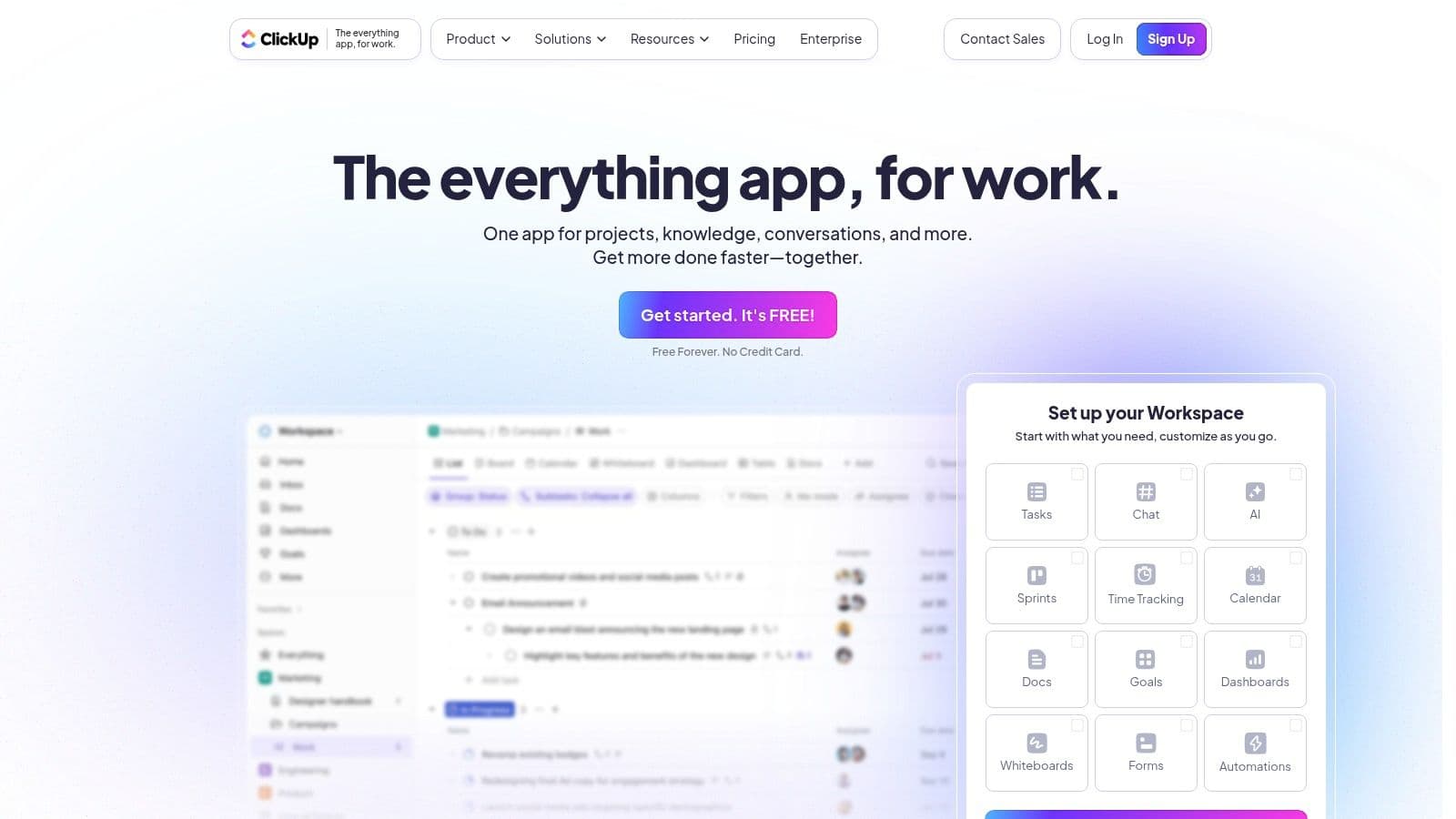
Features and Benefits
ClickUp's strength lies in its customizability and extensive features. Teams can tailor the platform to their specific needs, choosing the views and tools that best suit their workflows. Real-time collaboration features, like chat and whiteboards, foster seamless communication. The platform's robust project tracking and reporting capabilities enable data-driven decision-making.
Pros and Cons
- Pros: Highly customizable, comprehensive features, affordable pricing, real-time collaboration, robust reporting.
- Cons: Can be overwhelming for new users due to the sheer number of features, the mobile app offers fewer features compared to the desktop version.
Pricing and Use Cases
ClickUp offers a free plan with generous features, ideal for small teams. Paid plans start at $5 per user per month and unlock advanced features like increased storage and custom fields. Visit their website (https://clickup.com) for detailed pricing information.
Implementation and Recommendations
ClickUp is an excellent choice for teams seeking a powerful yet affordable team productivity app. Its customizability makes it adaptable to diverse needs. Start with the free plan to explore the core features. Gradually introduce new features to avoid feeling overwhelmed. ClickUp's comprehensive feature set makes it a strong contender among team productivity apps.
8. Jira
Jira is a project management tool tailored for software development teams, offering robust agile project management capabilities. It excels in managing complex projects with its customizable workflows, detailed tracking, and extensive reporting features. While renowned in software development, its highly configurable nature can also benefit other teams seeking granular control over their projects.
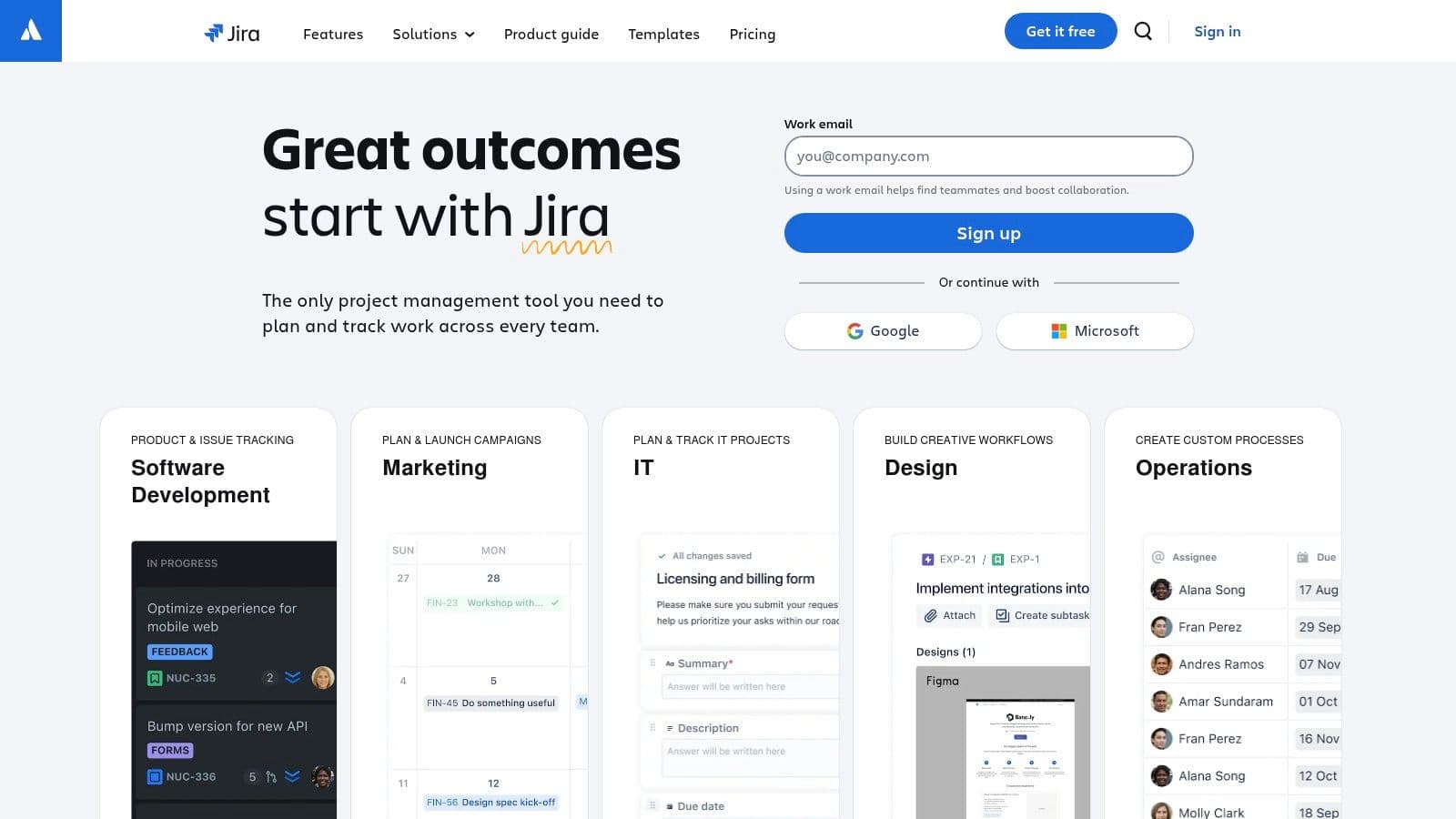
Features and Benefits
Jira's strength lies in its customizable project boards, backlog and timeline management, and advanced reporting and analytics. These features facilitate agile methodologies, enabling teams to track progress, identify bottlenecks, and adapt to changing requirements. Integration with development tools like GitHub streamlines workflows and improves team productivity apps utilization. Automated workflows further enhance efficiency by automating repetitive tasks.
Pros and Cons
- Pros: Robust for agile project management, extensive customization options, strong integration with development tools, detailed reporting.
- Cons: Steeper learning curve, can be complex for non-development teams, pricing can be a factor for larger teams.
Pricing and Use Cases
Jira offers a free plan for small teams (up to 10 users). Standard and Premium plans cater to larger teams and offer additional features, scaling in price based on the number of users. Visit their website (https://www.atlassian.com/software/jira) for detailed pricing information.
Implementation and Recommendations
Jira is ideal for software development teams and other teams requiring granular control over complex projects. Its powerful features and integrations make it a valuable team productivity app. However, be prepared for a learning curve. Start with a smaller project to familiarize yourself with the platform before deploying it across larger teams. Consider dedicated training for your team to maximize its potential.
9. Google Workspace
Google Workspace is a suite of cloud-based productivity and collaboration tools. It's become a staple for many teams, offering a centralized platform for communication, file sharing, and project management. Its strength lies in the seamless integration between its various applications, streamlining workflows and fostering real-time collaboration.
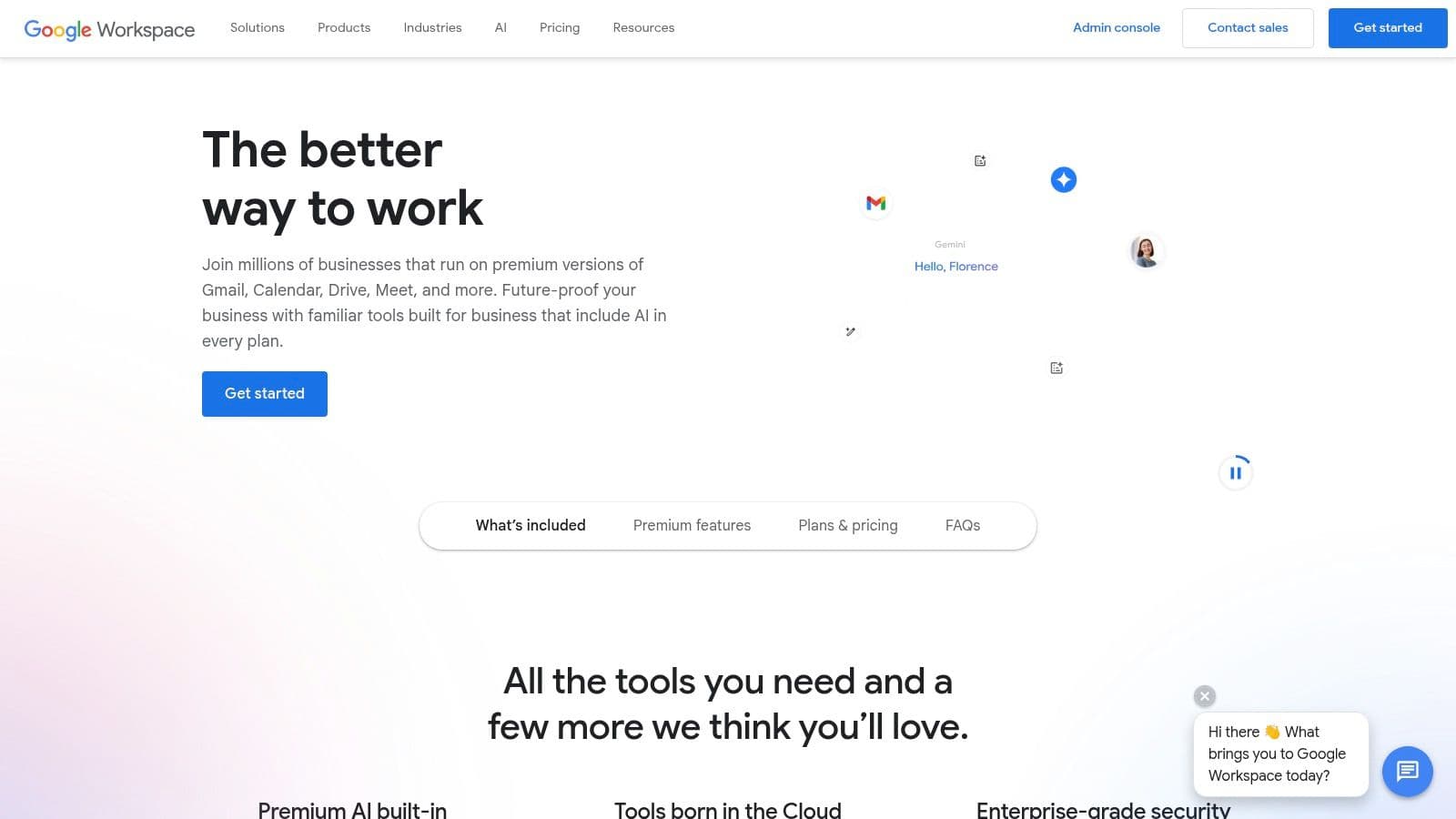
Features and Benefits
Google Workspace includes Gmail, Drive, Docs, Sheets, Slides, Meet, and Calendar. These tools integrate seamlessly, allowing users to transition effortlessly between tasks. Real-time co-editing features in Docs, Sheets, and Slides promote efficient teamwork and eliminate version control issues. Drive provides centralized storage and easy file sharing, facilitating collaboration on various projects.
Pros and Cons
- Pros: Seamless integration between apps, real-time collaboration features, accessible from any device with internet, cost-effective for basic plans.
- Cons: Requires internet connection for full functionality, potential privacy concerns with data stored on Google's servers, limited offline capabilities.
Pricing and Use Cases
Google Workspace offers various pricing tiers, starting with a free basic plan. Paid plans offer additional storage and features, catering to different business needs. It's suitable for teams of all sizes, from small startups to large corporations seeking a comprehensive team productivity app solution. Visit their website (https://workspace.google.com) for detailed pricing information.
Implementation and Recommendations
Implementing Google Workspace is generally straightforward. The intuitive interface makes it easy for teams to adopt the platform. Leverage the sharing and permission settings within Drive to maintain organized file structures and control access. While the free tier is suitable for basic needs, consider a paid plan for enhanced security and storage if dealing with sensitive data or large files. Google Workspace is a powerful tool for teams prioritizing seamless collaboration and centralized workflows.
10. Zoom
Zoom is a video conferencing tool that has become a ubiquitous part of modern teamwork. It provides high-quality video and audio meetings, webinars, and chat functionalities, enabling seamless communication and collaboration for remote and hybrid teams. Its widespread adoption stems from its user-friendly interface and reliable performance. Zoom's versatility makes it suitable for one-on-one meetings, large conferences, training sessions, and client presentations.
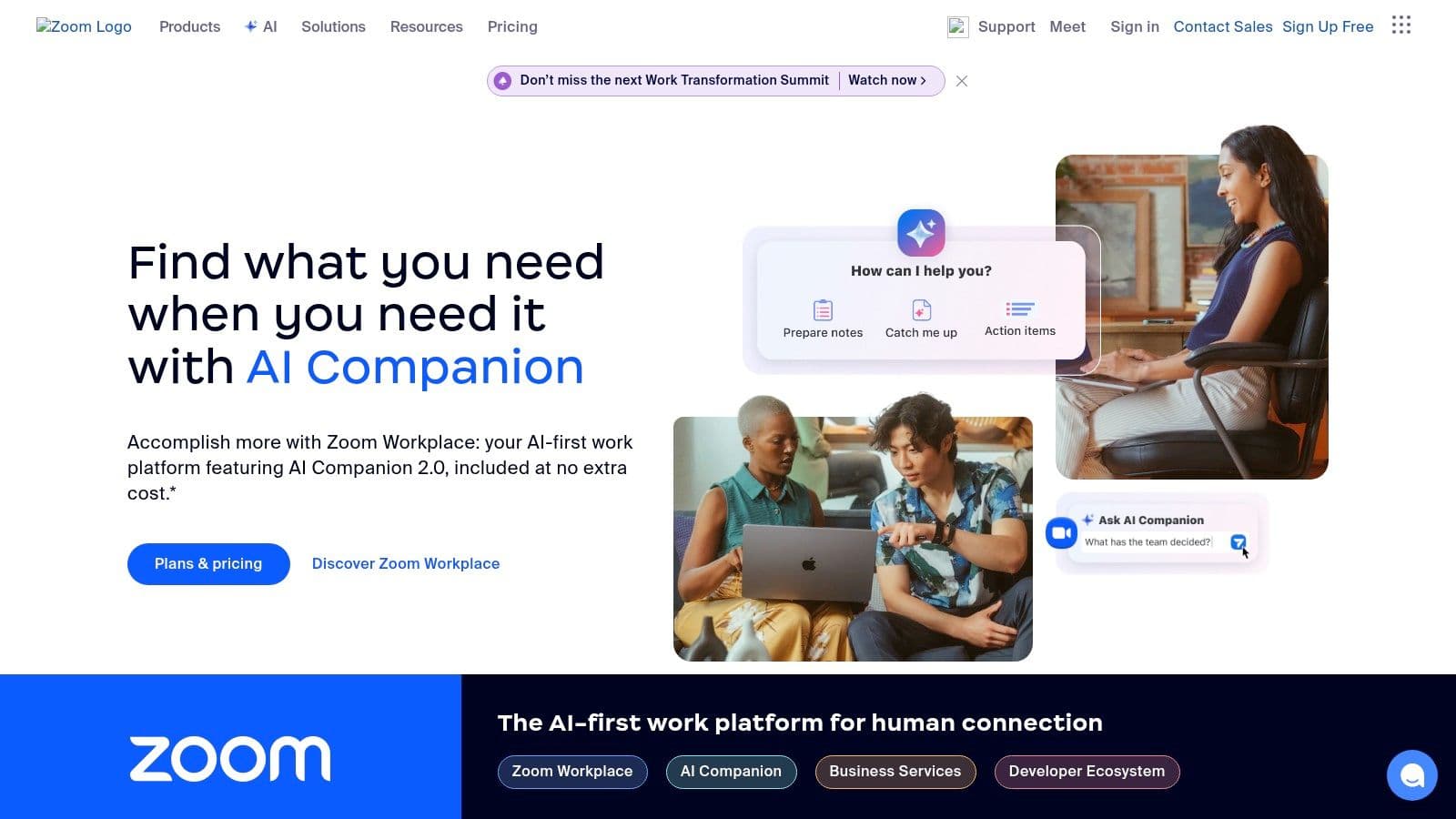
Features and Benefits
Key features include screen sharing, breakout rooms, and integrations with calendar and scheduling tools. Screen sharing facilitates collaborative work on documents and presentations. Breakout rooms are invaluable for dividing larger groups into smaller, focused discussions. Calendar integrations streamline scheduling and minimize logistical hurdles. Zoom's reliable performance and intuitive design significantly contribute to enhanced team productivity. For tips on running effective meetings, learn more about Zoom best practices.
Pros and Cons
- Pros: High-quality video and audio, user-friendly interface, scalability, robust features like screen sharing and breakout rooms.
- Cons: The free plan limits group meetings to 40 minutes. While past security concerns have been largely addressed, some users still have reservations.
Pricing and Use Cases
Zoom offers a free tier suitable for basic individual use and short team meetings. Paid plans remove the 40-minute limit and unlock additional features like cloud recording and larger meeting capacities. These plans cater to businesses and teams requiring more extensive functionality. Visit their website (https://zoom.us) for detailed pricing information.
Implementation and Recommendations
Implementing Zoom is straightforward. It’s available as a desktop application and a mobile app, ensuring accessibility across various devices. For optimal team productivity, consider establishing clear meeting protocols and utilizing features like breakout rooms and screen sharing strategically. While the free version is a good starting point, businesses will likely find value in the paid plans for their expanded capabilities and removal of time restrictions.
11. Todoist
Todoist is a task management tool that helps individuals and teams organize and prioritize tasks. It excels in its simplicity and cross-platform availability, making it accessible from anywhere. The platform offers robust features for personal task management and collaboration on team projects, making it a versatile solution for diverse productivity needs. Learn more about how Todoist and other tools can enhance your workflow in this article on how to stop wasting time.

Features and Benefits
Todoist shines with its intuitive interface, making task creation and organization a breeze. The project organization with sub-tasks allows for breaking down complex projects into manageable steps. Collaboration features facilitate seamless teamwork, while integrations with calendars and other tools streamline workflows. Productivity tracking helps monitor progress and identify areas for improvement.
Pros and Cons
- Pros: Simple and intuitive interface. Cross-platform availability. Effective for personal and team use. Seamless integration with other tools.
- Cons: Advanced features like reminders and labels require a premium subscription. Limited project templates can restrict initial setup for some users.
Pricing and Use Cases
Todoist offers a free version with core task management features, suitable for individuals getting started. The Pro plan ($5/month) unlocks advanced features, such as reminders and labels, ideal for power users. The Business plan ($8/user/month) offers team collaboration and admin controls, perfect for team projects and larger organizations.
Implementation and Recommendations
Todoist is an excellent choice for individuals, teams, and project managers seeking a straightforward yet powerful task management solution. Its ease of use combined with robust features contributes to enhanced team productivity. Start with the free version and explore the paid plans if advanced features align with your needs. For larger teams, the Business plan provides the necessary collaborative tools and administrative control for effective project management.
12. Miro
Miro is an online collaborative whiteboard platform designed for remote and distributed teams. It provides an infinite canvas for brainstorming, planning, and visualizing ideas. Miro excels in fostering creative collaboration and supports a wide range of use cases, from agile workflows and design thinking to customer journey mapping and mind mapping.

Features and Benefits
Miro offers pre-built templates for various use cases, accelerating project setup. Real-time collaboration features, including sticky notes, voting, and commenting, enhance team engagement. Integrations with popular team productivity apps like Slack, Trello, and Zoom streamline workflows. The presentation mode facilitates clear and engaging idea sharing.
Pros and Cons
- Pros: Highly interactive and engaging, facilitates creative collaboration, supports various use cases, integrates with popular team productivity apps.
- Cons: Can be resource-intensive on less powerful machines, some advanced features require a learning curve.
Pricing and Use Cases
Miro offers a free plan with limited boards and features, suitable for small teams or individual use. Paid plans start at $8 per member per month and unlock unlimited boards, advanced features, and enterprise-grade security. Visit their website (https://miro.com) for detailed pricing information.
Implementation and Recommendations
Miro is an excellent team productivity app for teams seeking to enhance visual collaboration and brainstorming. Its strength lies in its versatility and interactive features. While it can be resource-intensive, the benefits outweigh this limitation for most teams, especially those working remotely. Start with the free plan to explore the core features, and consider a paid plan as your team's needs and usage grow. Miro is a valuable tool for boosting team productivity and facilitating innovative thinking within a shared virtual workspace.
Team Productivity Apps Feature Comparison
| Platform | Core Features / Automation ✨ | User Experience / Quality ★★★★☆ | Value Proposition / Pricing 💰 | Target Audience 👥 | Unique Selling Points 🏆✨ |
|---|---|---|---|---|---|
| Fluidwave 🏆 | AI-driven auto-prioritization, multi-view task management | Distraction-free interface, instant responses | Free tier + pay-per-task delegation 💰 | Busy professionals, teams, freelancers 👥 | Flexible delegation, no subscription for assistants, deep-focus design |
| Slack | Channel messaging, voice/video calls, 2400+ app integrations | Intuitive UI, real-time communication ★★★★☆ | Freemium, limited message history in free 💰 | Teams prioritizing communication 👥 | Extensive integrations, organized conversations |
| Asana | Task assignments, timelines, automation | User-friendly with flexible views ★★★★☆ | Free basic, advanced features in paid plans 💰 | Teams managing projects & workflows 👥 | Robust integrations, reporting dashboards |
| Trello | Visual boards, drag-drop tasks, automation (Butler) | Simple, intuitive, mobile support ★★★☆☆ | Strong free plan; paid for advanced features 💰 | Small teams, simple project needs 👥 | Highly customizable, easy to learn |
| Notion | Notes, databases, real-time doc collaboration | Flexible, customizable, strong community ★★★★☆ | Free with limits; paid for added features 💰 | Individuals, teams, knowledge workers 👥 | All-in-one workspace combining many tools |
| Microsoft Teams | Chat, video meetings, file storage, MS 365 integration | Robust but can feel cluttered ★★★☆☆ | Included in MS 365 subscriptions 💰 | Enterprises, MS 365 users 👥 | Deep MS 365 integration, security features |
| ClickUp | Chat, whiteboards, Gantt, Kanban, sprint tools | Highly customizable, comprehensive ★★★★☆ | Free tier, affordable paid plans 💰 | Diverse teams needing customization 👥 | Broad feature set to fit workflows |
| Jira | Agile boards, backlog, reporting, dev tool integration | Powerful but complex ★★★☆☆ | Paid plans; free for small teams 💰 | Software teams, agile development 👥 | Strong for agile, deep development integrations |
| Google Workspace | Gmail, Drive, Docs, Meet, Calendar | Seamless collaboration, device access ★★★★☆ | Subscription-based plans 💰 | Teams needing cloud productivity suite 👥 | Integrated productivity apps |
| Zoom | HD video/audio, webinars, breakout rooms | Reliable, user-friendly ★★★★☆ | Free with 40-min limit; paid plans 💰 | Teams needing video conferencing 👥 | Scalable meetings, breakout rooms |
| Todoist | Task management, priorities, collaboration | Simple, cross-platform ★★★☆☆ | Free basic, premium subscription for features 💰 | Individuals & small teams 👥 | Effective personal & team task focus |
| Miro | Infinite canvas, templates, real-time collaboration | Interactive, engaging ★★★★☆ | Free tier with paid upgrades 💰 | Creative & remote teams 👥 | Collaborative whiteboard, diverse use cases |
Elevating Teamwork: Choosing the Right Productivity App
Navigating the world of team productivity apps can feel overwhelming. With so many options available, each boasting unique features, pinpointing the ideal solution for your team requires careful consideration. This article has explored twelve leading platforms, from communication hubs like Slack and Microsoft Teams to project management powerhouses like Asana and Jira. We've delved into their strengths, weaknesses, pricing structures, and ideal use cases, providing a comprehensive overview to guide your decision-making process.
Key Takeaways for Enhanced Productivity
Several key themes emerged from our exploration of these team productivity apps. Effective communication is paramount, and tools like Slack excel in this arena. Robust project management features, as seen in Asana and Trello, are crucial for keeping teams organized and on track. Furthermore, the rise of flexible work environments necessitates seamless collaboration, a strength of platforms like Google Workspace and Zoom.
Matching Your Needs to the Right Tool
Choosing the right team productivity app hinges on understanding your team's specific requirements. For smaller teams focused on communication and basic task management, a simpler tool like Trello might suffice. Larger organizations with complex projects might benefit from the robust features of Jira or ClickUp. Consider these factors:
- Team Size: A smaller team's needs differ significantly from those of a large enterprise.
- Project Complexity: Simple task management versus intricate project workflows demands different toolsets.
- Budget: Free options exist, but premium features often come with a price tag.
- Integration Needs: Seamless integration with existing software can significantly enhance productivity.
Implementing Your Chosen App Effectively
Successfully integrating a new team productivity app requires careful planning and execution. Begin with a clear understanding of your goals. Provide comprehensive training to your team. Start with a pilot program to identify any potential roadblocks. Encourage feedback and iterate based on real-world usage.
The Power of Optimized Workflows
Ultimately, team productivity apps serve a single, vital purpose: optimizing workflows. By streamlining communication, centralizing information, and automating tasks, these tools empower teams to work smarter, not harder. The result is increased efficiency, reduced stress, and a greater capacity for innovation. Choosing the right app can significantly impact your team’s performance and overall success.
Streamlining workflows and boosting team productivity is a continuous journey. Fluidwave provides a centralized platform for managing tasks, communication, and team resources, helping you navigate the complexities of modern teamwork. Interested in simplifying your team's workflow and enhancing collaboration? Explore Fluidwave today and discover how it can revolutionize your team's productivity. Fluidwave
Do less, be more with Fluidwave
Fluidwave combines smart task prioritization with an assistant marketplace — AI and human help, all in one productivity app.